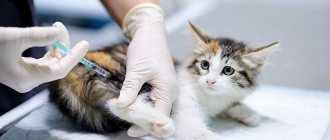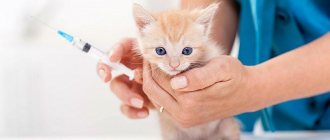Every cat owner knows that one of their first priorities is to take care of their pet. It’s not just about feeding and caring for appearance; disease prevention is of particular importance. There are specific ailments that pose a particular danger to warm-blooded animals, and the cat owner has the opportunity to enhance the protection of their furry pet through vaccination. One of the main vaccinations on the list of necessary ones is vaccination against rabies.
- 2 Why do you need a rabies vaccination?
- 3 Timing of vaccination
- 4 Preparation and implementation of vaccination
- 5 Post-vaccination period
- 6 Types of vaccines and their costs
6.1 Table: popular rabies vaccines for cats
6.1.1 Photo gallery: rabies vaccines for cats
Danger and modes of transmission of rabies
Rabies is caused by the Rabies lyssavirus virus, which can infect all warm-blooded animals without exception, including humans, so it is better for the animal owner to worry about the safety of coexistence in advance. Transmission occurs through the saliva of a sick individual during a bite. Also dangerous is contaminated saliva that gets on injured skin or mucous membranes. Having penetrated the body, the infection quickly spreads along the nerve fibers, penetrates the spinal cord and brain, where it accumulates and causes irreversible destruction. The incubation period, that is, the period from the moment of infection to the appearance of the first symptoms, can vary from 7 to 14 days.
The danger of the disease lies in its lethality for animals. A sick cat first becomes lethargic and timid, and then clearly expresses its aggression with attacks and bites. At the second manic stage of the disease, one of the most well-known symptoms is noted - the inability to swallow saliva due to spasm of the larynx, which leads to its constant flow from the mouth. At the last stage, paralysis of the entire body occurs, leading to inevitable death.
At the second stage of rabies development, the cat becomes aggressive, attacking and biting a person, which poses a direct threat to him of also getting sick.
Rabies in humans
Surely many of you remember the phrase that was used to scare you in childhood: “Forty rabies injections in the stomach.” Of course, we treat this phrase more as a joke. But there is still some truth in it. Let's figure it out.
It is rare to imagine a situation in which a person becomes infected with rabies from a wild animal. We live in a time when a person does not need to go into the forest to get food, but simply go to the supermarket. Therefore, the risk of contracting rabies from pets is much higher. And since sick cats are often much more aggressive than other animals, the risk of being infected by them is also much higher. The clinical picture of rabies, just like in animals, depends on the location of the bite. Depending on where the bite occurred and how deep it was, the disease will manifest itself at different speeds - if the virus entered the human body through a wound on the leg, the symptoms will appear more slowly, if on the face, then faster. Conclusion - the closer the site of injury is to the brain, the faster the symptoms will appear.
Signs of rabies in a person after a cat bite can become noticeable after 10 days, and there are cases when a person does not realize that he is sick for several months or even a whole year. Rabies is more common in children than in adults. This is because children are more likely to play with stray animals and may receive minor bites that they do not report to adults.
Just like in animals, with this disease the virus attacks the central nervous system. The main signs of rabies in humans are:
- active constant convulsive contractions of the respiratory and swallowing muscles;
- a sharp increase in salivation, profuse sweating;
- severe pathological changes in the respiratory and cardiovascular systems.
Another very clear sign of rabies in humans is the appearance of a scar phenomenon, unclear fears, and depression. The scar phenomenon is that at the site of the bite there is a very strong burning sensation, as well as a nagging and aching pain. The pain spreads along the nerve fibers located at the site of the bite. In addition, the bite site will become very red and the scar will swell. The emotional feeling and, accordingly, the behavior of the sick person will also change. The most indicative phobias (fears) with rabies will be the occurrence of hydrophobia (fear of water), aerophobia (fear of air), acousticophobia (fear of various sounds), photophobia (fear of light). The patient will begin to demonstrate a very specific reaction to any irritant: he will shudder and stretch his trembling arms forward, his body may experience a slight trembling or spasm, he will throw his head back, it will become difficult for him to take a full deep breath, and constant shortness of breath will appear. At the last stage of the disease, the person calms down, his hydrophobia and anxiety disappear, and the person becomes better psychologically. The body temperature rises above 40 degrees, the body becomes paralyzed, convulsions appear, and consciousness fades. Death occurs as a result of cardiac or respiratory arrest.
When the first symptoms of rabies appear, unfortunately, a person has practically no chance of recovery. Successful outcomes of the disease are extremely rare and they are truly isolated cases. Not all people take this disease seriously enough, not understanding and not knowing that the fatality rate of the rabies virus is 100 percent. And if you do not seek professional medical help in time, immediately after being bitten by a rabid animal, then the ending will be inevitable and unambiguous. As soon as a patient seeks help from a medical facility, doctors immediately begin a course of injections. On the first day, anti-tetanus serum and rabies vaccine are administered. In some cases, rabies immunoglobulin is also administered; these are ready-made antibodies to the rabies virus. Next, five more vaccines will be administered in accordance with the approved injection schedule. During the course of injections, you must follow all the necessary measures, do not overheat, do not become overtired, and completely abstain from alcohol.
Why do you need a rabies vaccination?
Vaccination is the only effective way to protect your cat from contracting a fatal disease. Administration of the drug according to the established scheme allows the body to form stable immunity to the virus. Many owners of domestic cats have a question: why vaccinate if the pet does not go outside and does not come into contact with sick individuals. Here it is worth understanding that no one is immune from accidents and high-risk situations, for example:
- a cat can jump out into the street due to the owner’s negligence or, for example, fall out of a window - it is impossible to guarantee that the animal will never end up on the street, even if only for a short time;
- a trip to a veterinary clinic or animal hospital is planned, where contact with an infected animal is also possible;
- a new pet will appear in the house, for example, a dog that will regularly go outside.
Rabies vaccination, taking into account the danger of the disease, is recommended for all cats without exception, but in some cases it is strictly required:
- the animal participates in breeding, attends cat shows - without vaccination against rabies, a representative of the breed will simply not be allowed to attend any event;
A cat will not be allowed to participate in the exhibition without the necessary vaccinations.
- trip abroad. Before traveling with a cat, the owner will need to receive a special certificate about the condition of his furry companion, which must contain notes about vaccinations;
- the cat is free-range or there are other pets in the house who regularly go outside.
Reactions to rabies vaccine
Usually a healthy animal tolerates vaccination without visible complications, but some cat owners are still afraid to vaccinate their pets. This fear dates back to the days when phenol, a highly toxic chemical, was added as a preservative to the rabies vaccine. After the procedure, many cats were severely poisoned and sometimes even died. Currently, this toxic substance is not used in anti-rabies drugs, so the maximum that can be observed in a kitten is minor depression (no more than 2-3 days). In some cases, as a result of subcutaneous administration of the drug, a lump may form in the cat. This reaction is considered normal and goes away without medical intervention after 2 weeks.
In order to prevent the development of anaphylactic shock, after administering the vaccine to a cat, the animal must be observed for 20 minutes. Veterinarians recommend that pet owners do not leave the veterinary clinic immediately after the injection, so that in case of shock the animal can receive professional help.
Vaccination dates
At the beginning of their life, kittens have passive immunity received from their mother, so they are not vaccinated during the first months. At the age of 12 weeks, the kitten must receive its first course of rabies vaccination. Unlike other standard vaccinations for cats, the rabies drug is administered once, without a second dose after a month .
Revaccination should be carried out regularly throughout the life of the animal: at the age of 1 year, and then once every one or three years (depending on the conditions of detention and the vaccine).
Vaccination frequency
To fully protect your pet, the rabies vaccination for cats must be repeated once a year.
In rare cases, exceptions to the rules are allowed: the Nobivac Rabies vaccine is capable of forming immunity, making cats immune to the disease for 3 years.
In this regard, a veterinarian may allow a cat to be vaccinated with this vaccine once every 3 years, provided that the cat is elderly or has chronic diseases. In any other cases, revaccination, even with the Nobivac Rabies vaccine, is carried out once a year.
Preparation and implementation of vaccination
Before vaccination, the animal must be properly prepared. One of the most important tasks is to treat against parasites, in particular, against worms. To do this, the cat is given special anthelmintic drugs, for example, Pratel tablets, Prazicide suspension, Drontal tablets, etc., 2 weeks before the planned vaccination date.
Two weeks before the rabies vaccination, the cat must be given an anthelmintic.
Also, on the eve of the procedure, you should make sure that your pet has no contraindications:
- period of teeth change;
- pregnancy or feeding kittens;
- state of immunodeficiency;
- increased body temperature;
- less than a month has passed since a course of antibiotics or surgery;
- disease.
If the cat is healthy and has no contraindications to vaccination, the doctor injects the selected vaccine. The drug is administered intramuscularly into the thigh area, but subcutaneous administration is also allowed.
Briefly about the disease
Rabies is a viral infection that causes a specific encephalitis. It easily infects any warm-blooded animal (dogs, cats, rodents, wild animals), and it can also infect humans! Its consequences are almost always death, and there are no effective treatments! It’s sad, but those who are sick are “put to sleep.”
The latent period is from 2-3 weeks to a year (!), but the animal’s saliva is already infectious to others - that’s what’s so cunning about it!
The virus dies at 100 degrees and is unstable to 5% solutions of alkali, phenol and formaldehyde.
Post-vaccination period
After vaccination, the doctor puts a mark in the veterinary passport and sends the animal and its owner home. In most cases, properly administered vaccination occurs without complications. The pet’s well-being may change noticeably, but this will be a variant of the normal reaction when the immune system is under heavy load: the cat sleeps more, is less active, does not want to play, looks inhibited from the outside, and may refuse to eat. If everything went as it should, then after 2-3 days the condition will return to normal. Complications are possible, although the likelihood of their occurrence is low. The cat may have an allergic reaction to the drug, lameness due to the needle getting into the nerve during the injection, or a tumor at the injection site (sarcoma). The following symptoms should be a warning sign:
- labored breathing;
- diarrhea and vomiting;
- convulsions;
- loss of consciousness;
- hair loss;
- lack of coordination.
High risks of developing sarcoma are provoked by adjuvants in dead vaccines - substances designed to enhance the immune response to the administered immunogen.
Considering the likelihood of complications, the owner needs to closely monitor his cat in the first days after vaccination and, if problems appear, immediately take him to the veterinarian. During the post-vaccination period, you should follow a number of rules:
- it is necessary to provide the cat with the opportunity to rest and recover;
- Avoid contact with other animals. The recommended duration of quarantine is 2 weeks;
- You can’t bathe your cat for the first week;
- It is important to protect the animal from stress, hypothermia, overheating and other stress on the body for at least 1–2 weeks after vaccination.
Rabies in cats, symptoms
There are several forms of rabies:
- Classic (or typical) rabies;
- "Silent" or "silent" rabies;
- Chronic (atypical) rabies.
Let's stop and look at each of the forms of this disease.
- The clinical picture of the classical form of rabies has three periods, with certain signs that very often overlap and intersect with one another:
- Prodromal period. In cats it usually lasts 1 day. At this time, the animal has a very noticeable change in behavior - quiet, calm and even reserved cats suddenly become active, restless, agile and friendly, while friendly animals can become, on the contrary, aggressive, begin to bite and scratch without any reason, and attack “from around the corner” at their owner or become depressed and inaccessible, hiding in dark places. Those. they begin to display character traits that are completely unusual for them. Aggression in cats with rabies is observed more often than in dogs! And, gradually, in a cat, any of the states goes into the stage of excitement.
- A period of excitement (or “frantic frenzy”). This is the longest period of all three existing ones. On average, this period lasts about a week (6-8 days), but sometimes it may be completely absent. In this case, immediately after a characteristic change in the behavior of the animal, the owners of the furry, mustachioed four-legged pets will see the final stage - paralysis. During the period of excitement, infected animals are most dangerous to others, they are most aggressive, and accordingly the disease spreads most easily. The cat becomes extremely nervous, irritable and angry. Attacks of rage and inappropriate behavior for cats will be triggered by sounds, bright lights or any sudden movement . During this period, muscle tremors and uncoordinated movements may begin. It becomes difficult for the animal to swallow due to a spasm, which later turns into paralysis of the laryngeal muscles. The cat's appetite decreases greatly or disappears completely and the animal completely refuses to eat. The cat may try to chew the carpet and floor, try to bite and gnaw various things unsuitable for consumption. Diarrhea and vomiting may occur. The cat will begin to drool and the owner will see excessive drooling and/or foaming at the mouth. The drooling will be so strong that the fur around the animal's muzzle and neck will be constantly wet, disheveled, matted and dirty.
- Paralysis (“silent phase”) is characterized by convulsions and shaking of the whole body. The animal may begin to “throw”. After this, coma or immediate death is possible. How long do cats with rabies live at this final stage of the disease ? The death of the animal most often occurs from respiratory arrest or exhaustion within 1-3 days.
This is a classic picture of how rabies manifests itself in cats. However, there are other forms of this disease, when the symptoms of rabies in cats are not so aggressive, but at the same time the animals pose a danger to others. In any case, if there is even a slight suspicion of rabies, you need to pay maximum attention to all changes in the cat’s behavior.
- The “silent” or “silent” form of rabies is the development of paralysis without the stage of excitement. Recently, this form of the disease has begun to be observed more and more often, and in some regions it already dominates over the classical one. In this case, how can you tell if your cat has rabies? Also by changing the pet’s behavior. The animal will have an indifferent and lifeless look “into emptiness.” There will also be increased salivation, the lower jaw may sag, refusal to eat, the voice may become hoarse, problems with the eyes will appear - “wandering eyes”, the cornea of the eye becomes cloudy, strabismus appears, and different pupil sizes are observed. Finally, paralysis and death occur.
- Chronic or atypical rabies. This type of rabies can last a really long time – up to 3 months. or even 1 year. This form of the disease is characterized by changes in the gastrointestinal tract - first diarrhea or intestinal paralysis, then hypersthesia (increased sensitivity to irritants), paralysis, impaired motor skills, depression, followed by temporary or long-term improvement. The diagnosis can only be made posthumously. In cats, chronic (recurrent) rabies has only been observed under experimental conditions.
In kittens, the symptoms of this disease are exactly the same as in an adult animal. The only difference is that the disease progresses much faster - the small kitten “goes away” in a few days.
Types of vaccines and their costs
Rabies vaccines are predominantly single-component, since the timing of administration according to the vaccination calendar differs from most other viral diseases for which cats are vaccinated.
Table: popular rabies vaccines for cats
| Name | Manufacturer | Vaccine type | Release form | Cost per dose |
| Defensor-3 | Zoetis LLC, USA | Monovaccine with inactivated rabies virus | Suspension for injection | 120 rubles |
| Nobivac Rabies | Intervet International BV, Netherlands | Monovaccine with inactivated rabies virus | Suspension for injection | 150 rubles |
| Rabizin | Merial, France | Monovaccine with inactivated rabies virus | Suspension for injection | 150 rubles |
| Quadricate | Merial, France | Complex vaccine for cats against distemper, herpes, calicivirus and rabies. The rabies virus in the drug is inactivated. | A dry white mass in a bottle, representing a mixture of rabies and distemper viruses, and a separate bottle with a solution of herpes virus and calicivirus. | 700 rubles |
Photo gallery: rabies vaccines for cats
Quadricat is a multicomponent vaccine that protects a cat from 4 diseases at once (rabies, panleukopenia, calicivirus and herpes)
Nobivac Rabies is an anti-rabies vaccine for warm-blooded animals, produced in the form of a ready-to-administer suspension
The Defensor-3 vaccine, produced in the USA, is single-component, that is, it protects the animal from only one disease - rabies.
Rabizin is an anti-rabies vaccine for cats that contains an inactivated virus that causes the disease.
Reviews of rabies vaccines
Both dogs and cats are vaccinated with the nobivac rabies vaccine. I have two cats, we vaccinate them as required once a year in the spring. Wherever you vaccinate, there is a risk of a “ball” forming under the skin at the injection site; there is nothing wrong with this if the animal behaves normally. Don’t press it, just keep an eye on it; in a couple of months, for us personally, everything will resolve itself. My cats tolerate the vaccination well, as if nothing was happening. The doctor removes the veterinary passport sticker from the cone, pastes it on the appropriate column, puts the date of vaccination and the clinic stamp.
rovione
https://irecommend.ru/content/doveryaem-1
Our eldest cat is already 6 years old. His first vaccinations were given with the Quadricat vaccine. from Merial. This is a French company. Previously, we did not know what exactly a good vaccine was. Therefore, the doctor decided at his own discretion. Then they started using Vakderm (Polivak and Purevax were also recommended). The cat tolerated the vaccination well. I was feeling great, I was moving actively, I had an appetite. There was no goose at the injection site. Everything went well. So I recommend it!
Evelina2622
https://otzovik.com/review_3879300.html
On Saturday, November 1, 2015, all cats (those who were healthy) were vaccinated against rabies with Defensor. During the 5 days of observation, everyone felt excellent, there were no problems. Cats have good immunity for a year; according to research from those clinics that are involved in processing the travel of animals abroad, it is the Defensor vaccine that gives high titers in the study. In general, we recommend it for cat owners to use before the start of the summer season))))
Shelter Valenta
https://vk.com/wall-15237006_7099
Urgent measures
If the cat behaves somewhat unusually, especially if it is able to freely go outside the apartment or house, then it is advisable to urgently visit a veterinary clinic. A test for rabies exists, but is not routinely performed because a negative result does not guarantee the absence of the disease. Therefore, if rabies is suspected, the veterinarian will quarantine the animal and monitor the symptoms. If the doctor understands that the cat is not sick with rabies, then she will be given help. Otherwise, the veterinarian waits for the death of the animal to examine the brain tissue for the presence of Babeshi Negri bodies and make a diagnosis of RABIES. The owner must go to the clinic and undergo a course of anti-rabies or rabies injections.
It should be noted that treatment of rabies is prohibited, since there is a high risk of infection of veterinary clinic staff.










